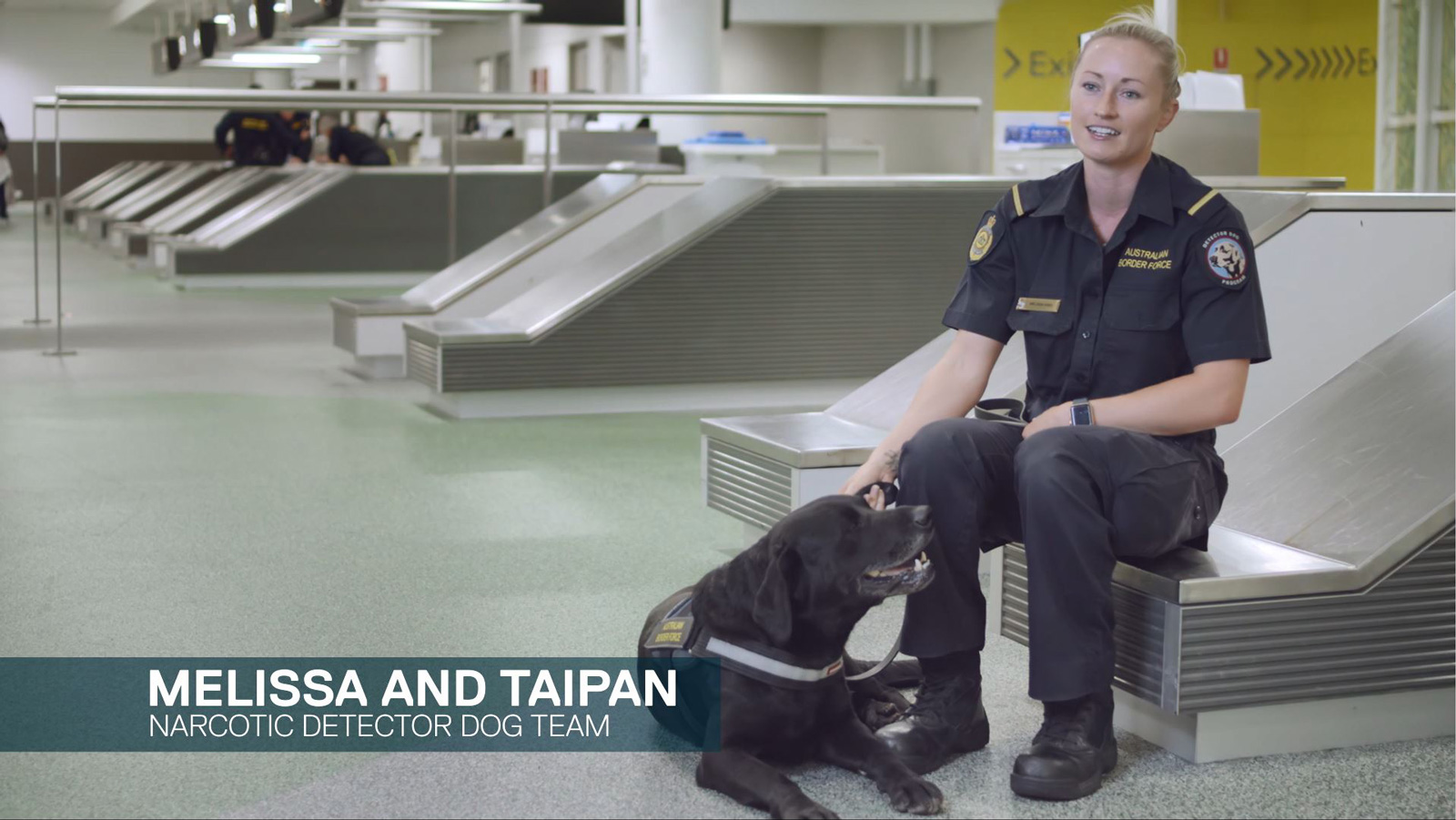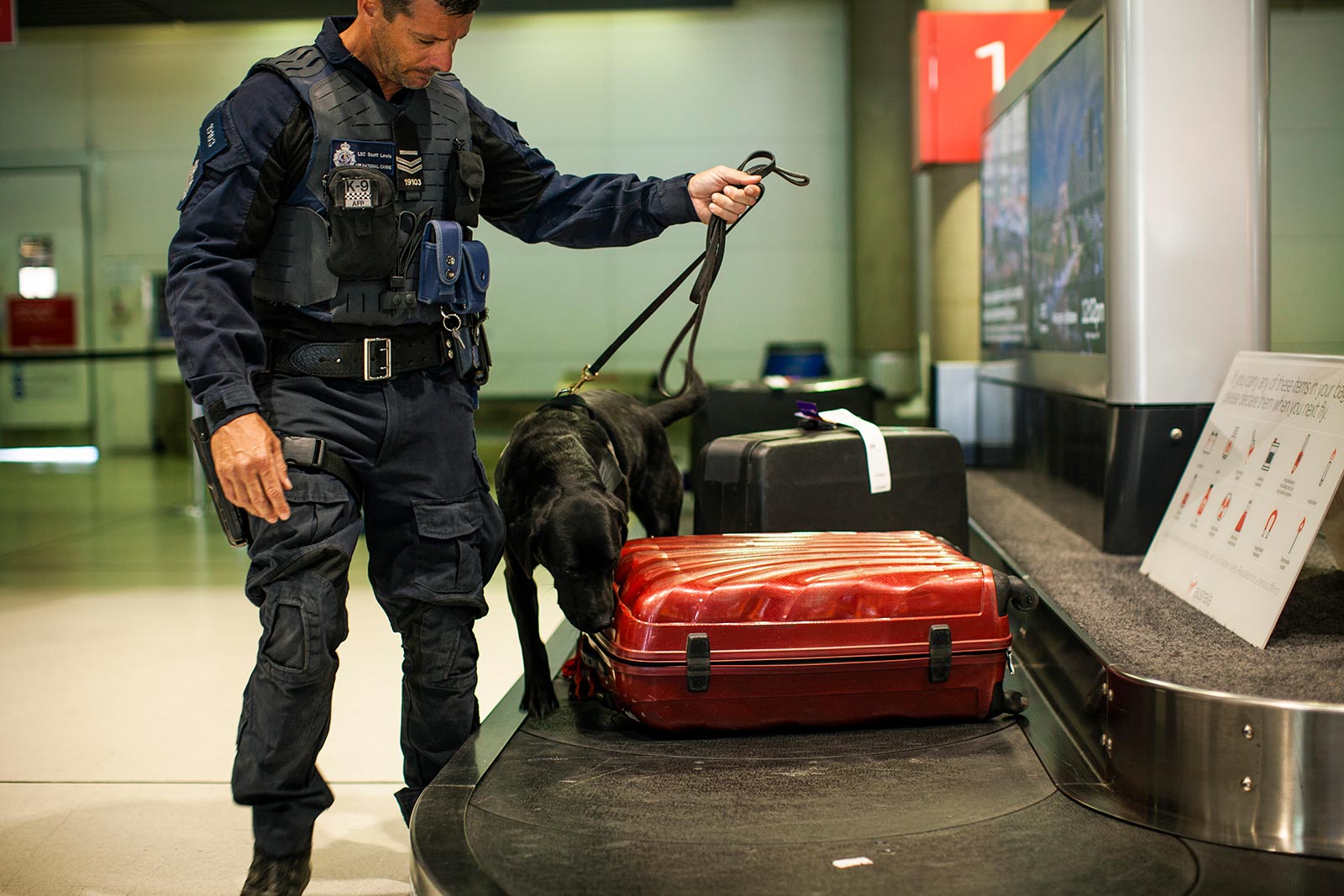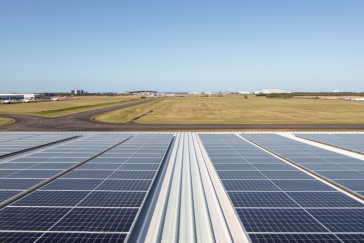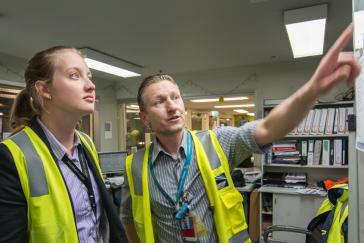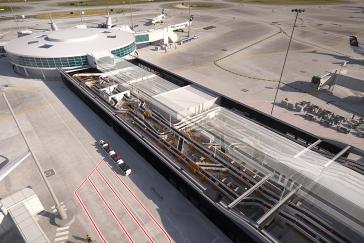When it comes to protecting Australia’s borders against threats such as narcotics, explosives and introduced pests and diseases, there is an incredibly cute resource used by numerous government agencies and departments at our international airports, and for very good reason.
Puppers! The Department of Agriculture and Water Resources, the Australian Border Force (ABF) and the Australian Federal Police (AFP) all utilise canines at Brisbane Airport, and they all work in conjunction with human offsiders to deliver a coordinated and highly effective capability to detect, deter and mitigate various threats to our aviation environment and the wider community.
The reason for this is pretty amazing. Where most humans are dependent on their sight to see the world, dogs interpret the world through their nose as they have an olfactory system (sense of smell) that is completely different to anything else on the planet. Dogs have two different air passages – one for breathing and one for smelling. The passage through which dogs smell air contains highly specialized olfactory receptor cells, responsible for receiving smells. A dog’s nose contains about 225-300 million smell receptors compared to just 5 million in a human nose.
Additionally, dogs can remember all the different smells they have sensed throughout their life as their brains have a much larger olfactory cortex when compared to humans (40 times larger). Yep, as if we needed further proof that dogs are the best…
Lisa and Udon (Donnie), The Department of Agriculture and Water Resources - Biosecurity detection
Lisa and Udon (aka Donnie) are Biosecurity Officers with the Department of Agriculture and Water Resources, and they work to protect Australia’s agricultural industries, environment, economy, and human health by ensuring exotic diseases and pests do not enter the country.
“Our job is really important. It’s our job to actually help sniff out items that could potentially have a threat to Australia, whether that be pests and diseases located on items such as fruit and vegetables, and seeds and nuts that can be concealed in passengers’ bags.”
The Department of Agriculture and Water Resources source suitable Labradors from the ABF detector dog breeding program before undergoing training to become biosecurity detector dogs. Donnie is no different. Eight years ago, he was sourced from the ABF’s ‘U’ litter. He was the only yellow pup in the group and he also happened to look like a noodle, so the name Udon stuck.
“Donnie is very highly trained. He had an initial six-month starter course and from then on, he gets continual training day in day out on the job. Donnie has found plant material in hold bags, plant cuttings as such – things like frangipanis, mustard stick, fruit and vegetables, even food off a plane that people forget to declare.”
Donnie is one of six biosecurity detection dogs working at Brisbane Airport and one of 45 deployed at international airports, mail centres and cargo ports across the country. Lisa explains they ‘multi-handle’ the dogs across Australia, so she isn’t always paired with Donnie. The dogs work on average 10 hours a day (with lots of breaks in between) for no more than four days in a row before having a few days off, and they always get results.
“On a normal day, these guys can screen up to about 400 passengers each. Hit-wise, we can range from up to 20 hits a day where we can get fruit, sandwiches, concealed items such as seeds and things like eggs and animals. It ranges from day to day depending on what’s come in and where the passengers are coming from.”
Biosecurity detector dogs are trained to smell more than 200 target items including things like fruit, vegetables, meat, seeds and plant materials. You can expect to see them once you have moved through the passport control area and collected your luggage.
“In a year, we can seize around 33,000 biosecurity risk items, potentially saving us from things like Foot and Mouth disease - things that can actually cost Australia multi-millions of dollars if they wipe out an agricultural industry.
“Not only is my job important, it’s important for passengers and travellers to actually make the effort to declare their items they bring into Australia and to hopefully help us prevent some potential pests and diseases entering the country.”
Melissa and Taipan, The Australian Border Force - Narcotics detection
Melissa and Taipan work for the Australian Border Force and are based in Brisbane. Taipan is seven years’ old and specialises in narcotic detection, trained to detect cannabis, cocaine, ice, ecstasy, heroin and pseudoephedrine.
“It’s a very important job. We are the frontline for providing mass screening at the border, so we deploy in a range of areas including the airport so as soon as passengers and their bags come off an aircraft, we will be there with the dogs to search everything.”
Labrador puppies from the ABF detector dog breeding program spend the first 12 to 18 months of their lives with foster families down in Melbourne. If they are deemed suitable to be a detector dog, they then start an intensive six-month training program before being paired with a trainer and undergoing further training. Their careers usually last around eight years where they will specialise in detecting either narcotics, firearms, explosives, currency or tobacco.
Taipan is one of 13 ABF detection dogs in Brisbane that are deployed across the entire border continuum, including airports, cruise ships, commercial vessels, cargo facilities and mail centres. A normal day at Brisbane Airport will see them search for around five to 10 minutes per flight with a rest in-between flights.
“We deploy the dogs and they search passengers and bags. If they find what we call a target odour, they’ll go into a conditioned response which is a s-i-t. When the dog does that, we will praise them, so we verbally give them praise, we give them a pat. Otherwise we will throw in a rolled up towel which we call a dummy, because in the dog’s mind, that’s what they think they are looking for – they’ve been trained to think that the target odour is actually a dummy.”
Taipan wears Muttluks on his paws to protect surfaces and give him more traction when searching the baggage carousels, and they are about the cutest thing you’ll see. If Taipan identifies a bag, a second ABF officer known as a pad scout will follow the bag until it is picked up by a passenger. They then take the passenger and bag to the back of the border force hall where they will conduct an examination of the bag to determine what the dog has responded to.
“Taipan found eight kilograms of cannabis in a house last year. He’s had several detections in the airport. His largest one was THC (Tetrahydrocannabinol) lollies and chocolates. The passenger had purchased them overseas, believed that he could bring them back into the country, but he didn’t declare them because he knew he couldn’t do that. There were small amounts in each one but it actually added up to a large amount.”
Scott and Naya, The Australian Federal Police - Firearms and explosives detection
The AFP is the primary law enforcement agency at the nine major airports across the country. The AFP’s presence at Brisbane Airport includes Airport Operations officers who deliver a coordinated, highly visible law enforcement capability to detect, deter and mitigate threats.
Scott Lewis is a Leading Senior Constable and Canine Handler based at Brisbane Airport, where he works alongside Firearms and Explosives Detector Dog (FEDD) Naya.
Like the ABF, the Australian Federal Police develops and maintains dogs for specific disciplines including firearms and explosive detection, currency and drug detection, as well as general purpose and tactical operations. To make the grade, they’ve got to be an exceptional dog.
“We separate the different capabilities because the responses and the actions that we (do) for explosives as opposed to drugs is totally different, and it would also be impossible to keep the skill set up if they had the dual capabilities.”
Naya is a two-and-a-half-year-old black Labrador affectionately known as ‘Hoover’ for her speedy eating abilities. She is the epitome of staunch and infectious joy. As a FEDD, she is primarily involved in screening incoming and outgoing passengers, searching incoming baggage and cargo, and is even called upon for operational activity in the community.
“Naya is a pretty resilient dog. She’ll bust through anything to get a result for me. I’m pretty proud of us as a team for what we’re doing. She’s pretty amazing in what she does, and it’s obviously an important role.
“We’re out there on the front line, protecting the Australian public when they’re travelling. The purpose of us being at the airport is part of a multi-layered security screening process. She’s a small part of it, but she’s basically there to detect firearms and explosives.”
Scott allows Naya to search for around 15 minutes before giving her a few minutes break to ensure she is performing optimally, but he always accounts for specific conditions and weather when working with her.
Like the Department of Agriculture and Water Resources and the ABF, the AFP’s detector dog training is based on repetition and reward. The on-going success of these detector dog programs is undoubtably down to the handlers, who ensure the dogs are well looked-after and are not bored with performing the same duties day after day.
“These dogs are extremely important to us as handlers. I love this job, because where else can you come every single day and work with these guys?! I also love the problem-solving aspect of it. The dogs develop issues along the way, and you’ve got to try and fix those and get them into their best operational capacity.”
As Scott so aptly points out, having a dog as a work partner is great. After all, the conversation’s always good and they’re easy to get along with. But more importantly from a law enforcement point of view, dogs have a skill that far exceeds that of any human or piece of technology.
“Dogs have been used for a number of years in detection work and they’ve proven time and time again to be more efficient and probably more detailed than we can ever be.”
“They’ve also got the ability to distinguish between odours. So, if we were to walk into a room and smell a margarita pizza, the dog would walk into the same room and smell the pizza base, the tomato in the sauce, the basil, the oregano, the cheese – they can distinguish between all different odours.”

